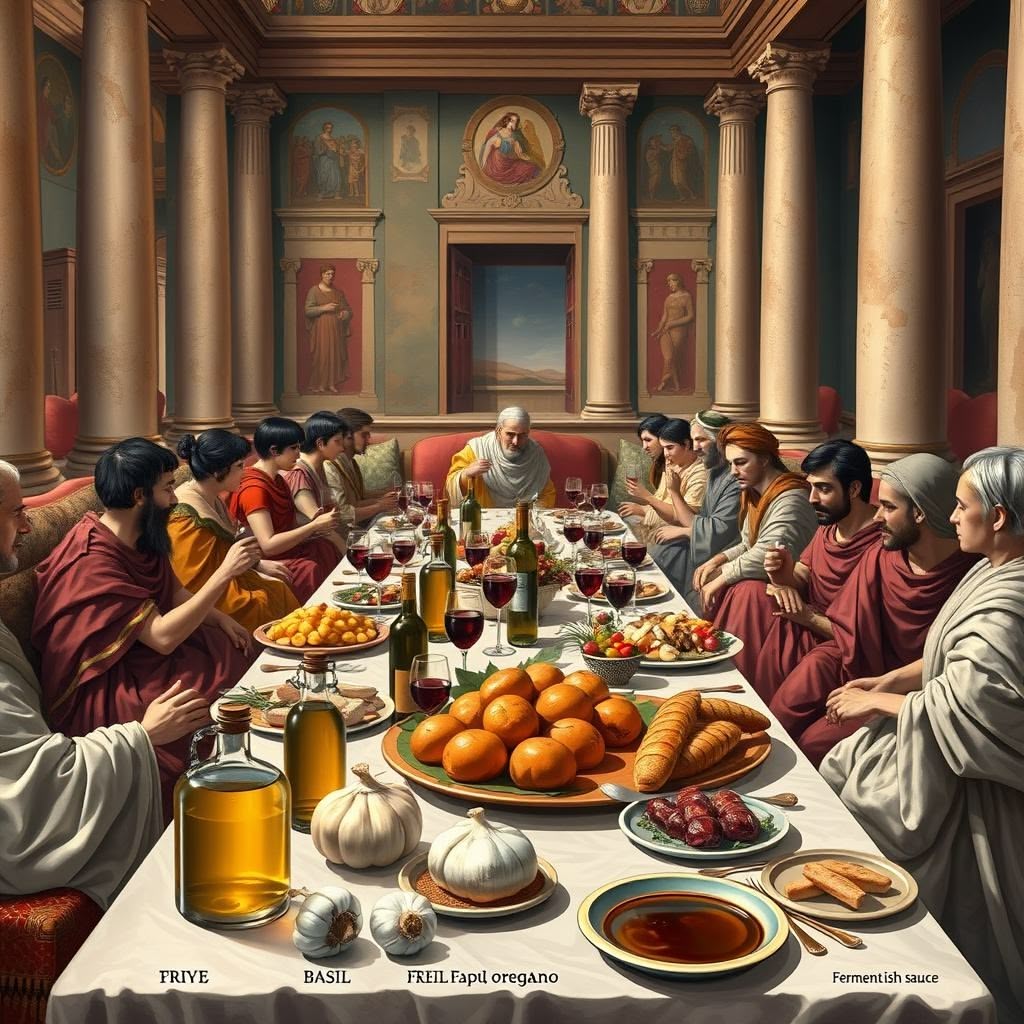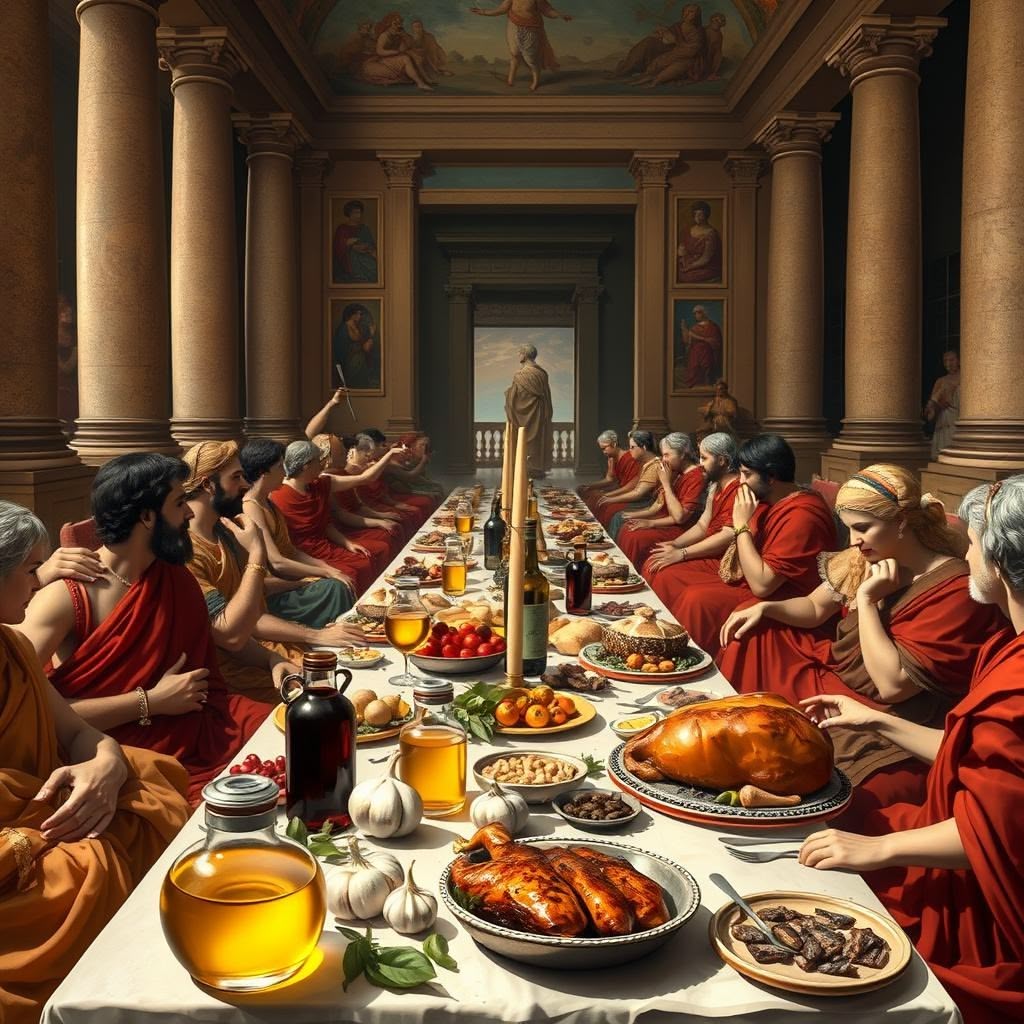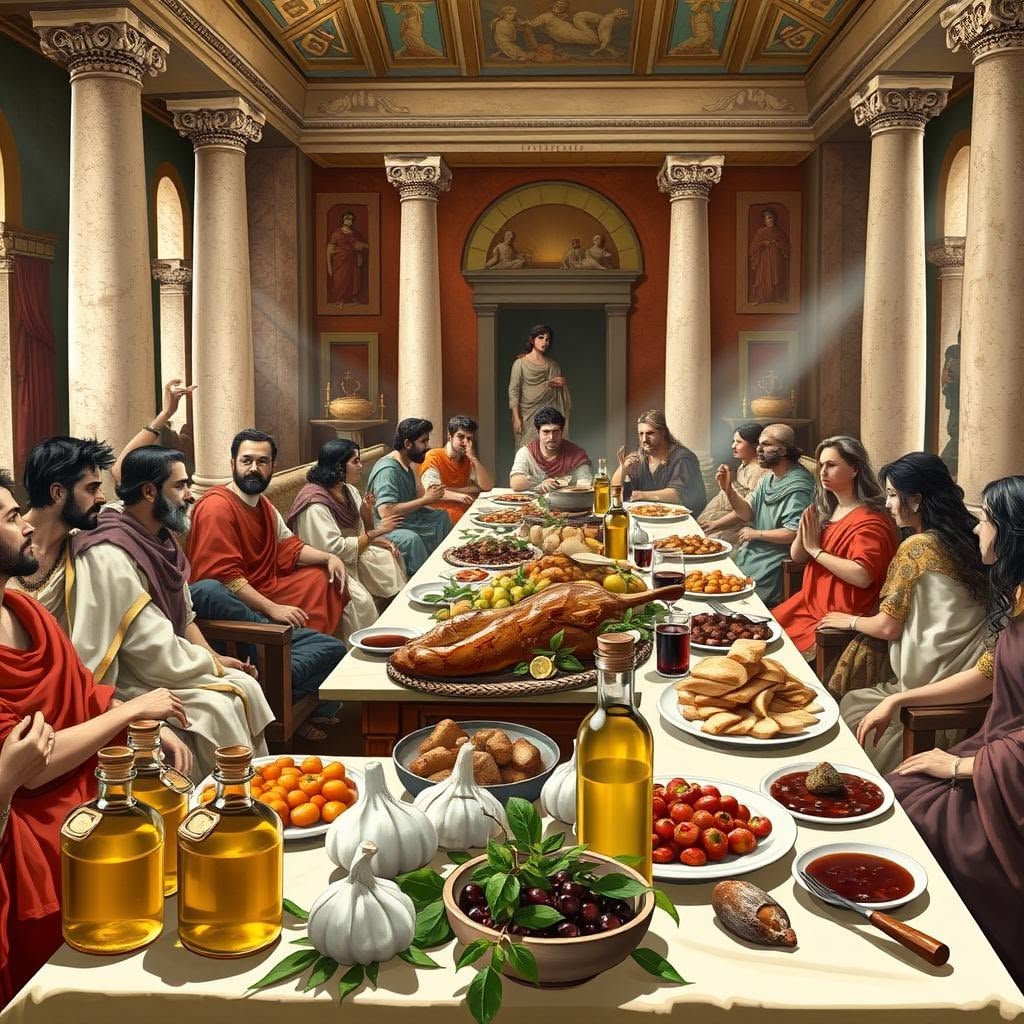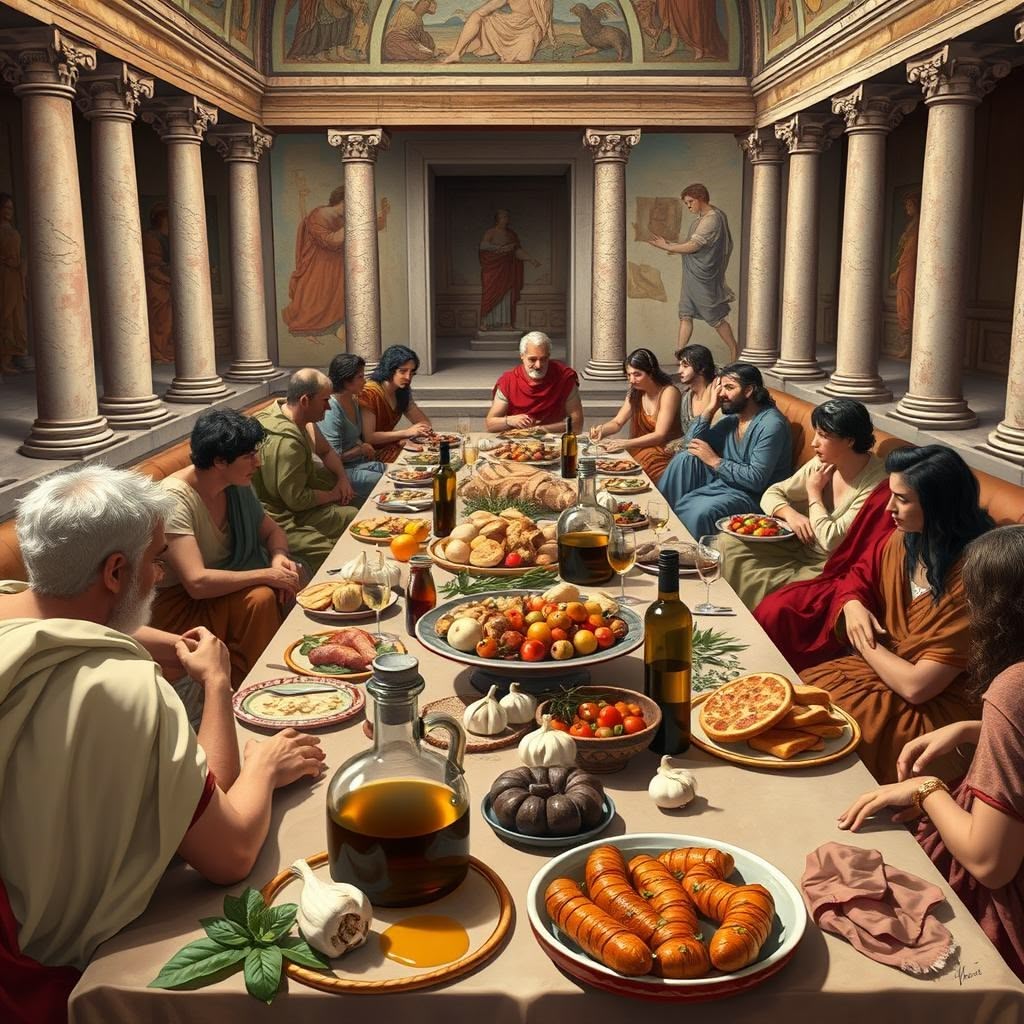Ancient Roman cuisine is a fascinating blend of culinary traditions that still impacts modern cooking. From basic ingredients to extravagant banquets, the food innovations of Ancient Rome have greatly influenced our dining experiences today. By studying the origins of our culinary practices, we can better appreciate the flavors and methods that have endured over time.
To fully grasp how ancient Roman cooking has shaped contemporary gastronomy, we must also examine the larger picture of Roman society. This includes understanding their legal systems, religious beliefs, and even the rights of women during that period. These societal factors not only influenced culinary practices but also affected how food was valued and enjoyed.
Additionally, the impressive architecture of the Romans, showcased in their remarkable engineering feats, played a part in their gastronomy. The buildings they constructed often hosted lavish feasts and gatherings, further integrating these food customs into their culture.
It’s intriguing to explore how these various aspects connect and enhance our understanding of ancient Roman cuisine. Join us as we embark on this journey to uncover the ways in which its legacy continues to shape our eating habits today.
Key Ingredients and Techniques in Ancient Roman Cooking
The flavors of ancient Roman cuisine laid the foundation for modern cooking, especially within Italian gastronomy. Central to this culinary tradition was olive oil, which was prized not just as a cooking medium but also as a flavor enhancer and dressing. This ingredient remains indispensable today, valued for its health benefits and rich taste.
Garlic served both culinary and medicinal purposes, imparting depth and aroma to dishes. Alongside garlic, a variety of herbs like basil and oregano were staples. These herbs contributed freshness and complexity, defining the character of many ancient recipes that continue to inspire contemporary chefs.
The sophistication of culinary techniques used in ancient Rome reveals a timeless mastery:
- Slow roasting and grilling: Methods that develop intense flavors in meats and vegetables, still fundamental in modern kitchens.
- Use of sauces and condiments: Fermented fish sauce, known as garum, acted much like today’s soy sauce or Worcestershire sauce, adding umami and saltiness.
- Preservation methods: Salting, drying, and pickling allowed Romans to extend ingredient shelf life—practices widely adopted in current culinary arts.
- Layering flavors: Combining sweet, sour, salty, and bitter elements was common to create balanced dishes—an approach central to gourmet cooking.
These ingredients combined with time-tested techniques illustrate how Roman culinary practices shaped cooking styles that remain relevant. The emphasis on fresh herbs, olive oil’s versatility, and sophisticated preparation methods form a core legacy from ancient Rome that continues to influence kitchens worldwide.
Understanding this legacy requires an exploration into the broader context of ancient Rome, including its governance structure which transitioned from monarchy to a complex political system during the Roman Republic, influencing modern democracies. Additionally, the philosophical influences such as Stoicism that shaped Roman thought, along with the military prowess of the Roman Army which played a crucial role in the empire’s expansion and upkeep, collectively contributed to the rich tapestry of Roman culture that includes its culinary traditions.

The Evolution of Pasta: From Lagane to Lasagna Noodles
Pasta has a long history in Italy, dating back to ancient Roman times when the early forms of pasta, like lagane, were introduced by the Romans. This precursor to modern lasagna noodles was made from a simple mixture of wheat flour and water, showcasing the humble yet versatile nature of pasta in Roman cuisine. Over the years, pasta dishes in Italian cooking have evolved, incorporating regional variations and diverse ingredients to create a wide range of flavors and shapes that we recognize today.
The Influence of Cucina Povera
The influence of ‘cucina povera,’ or peasant cooking, has had a significant impact on shaping contemporary Italian pasta dishes. This culinary tradition emphasized resourcefulness and creativity with limited ingredients, leading to the development of hearty and satisfying pasta recipes that are cherished for their simplicity and robust flavors. As a result, pasta became a staple in Italian households, offering a comforting and affordable meal option that could be easily customized to suit different tastes and preferences.
Cultural Shifts and Socio-Economic Factors
The evolution of pasta in Italian cuisine reflects not only changes in cooking techniques but also cultural shifts and socio-economic factors that have shaped our perception of food. From the basic lagane of ancient Rome to the intricate layers of lasagna noodles today, pasta continues to be a beloved symbol of Italian gastronomy. It embodies centuries of tradition and innovation that have influenced kitchens around the world.
Roman Feasting Traditions and Their Impact on Modern Dining Culture
Ancient Roman feasts were extravagant events that showcased not only culinary abundance but also social status and cultural sophistication. These lavish gatherings often lasted for hours, featuring a carefully orchestrated sequence of dishes designed to delight all the senses. Guests reclined on couches arranged around low tables, enjoying a variety of appetizers, main courses, and desserts served in multiple courses.
Key characteristics of these feasts included:
- Variety and abundance: Menus often featured exotic ingredients such as peacock, dormice, and imported spices alongside staples like fish, poultry, and fresh vegetables.
- Multi-course structure: Meals were divided into distinct segments—gustatio (appetizers), prima mensa (main courses), and secunda mensa (desserts)—a format that closely resembles modern multi-course dining experiences.
- Focus on conviviality: Feasts were social events centered on conversation, entertainment, and shared enjoyment of food and drink. This emphasis on communal dining fostered a sense of connection among participants.
The impact of these traditions can be seen in today’s dining culture. Multi-course meals remain a hallmark of fine dining worldwide, reflecting the Roman approach to pacing and variety during a meal. The spirit of conviviality continues to shape how people experience food together—whether at family gatherings, celebrations, or restaurant settings.
Gastronomic innovations from Ancient Rome still influencing modern cuisine extend beyond ingredients and recipes; they encompass the very way we structure meals and appreciate the social dimension of eating. This legacy enhances the richness and depth of contemporary culinary experiences by reminding us that food is as much about community as it is about flavor.
These feasting traditions are but a fragment of the larger tapestry woven by the rise and fall of the Roman Empire. This ancient civilization has left an indelible mark on the world, shaping politics, culture, and society in ways that continue to resonate today. Furthermore, the engineering feats achieved during this era have had lasting impacts on future generations, serving as a foundation for contemporary infrastructure systems as highlighted in this article about Roman engineering feats.
Moreover, the influence of Roman mythology on modern culture further underscores the profound legacy of this ancient civilization. The transition from monarchy to a republican system marked by the birth of the Roman Republic represents another pivotal moment in history that continues to influence modern political structures.

Julius Caesar’s Culinary Conquests: Expanding Flavors in Roman Cuisine
Julius Caesar’s military campaigns did more than reshape the Roman Empire politically; they left a significant mark on its food culture. His conquests opened the gates to an influx of new ingredients and culinary ideas that enriched Roman cuisine. Through his expansions into regions such as Gaul, Egypt, and parts of the Middle East, Rome gained access to exotic spices, fruits, and cooking techniques previously unknown or scarce in the city.
Key impacts of Julius Caesar’s influence on Roman food culture include:
- Introduction of new ingredients: Spices like cumin and coriander, along with fruits such as pomegranates and dates, became part of the Roman pantry. These additions diversified flavors and textures in everyday dishes.
- Expansion of trade routes: The empire’s extended reach allowed for greater importation of luxury foods like silphium—a now-extinct plant highly prized for its unique flavor—and various types of fish sauces beyond the traditional garum. Such trade routes were essential, much like the Roman roads that facilitated movement and commerce throughout the empire.
- Cultural exchange through conquest: Soldiers and settlers brought back cooking methods from conquered territories. Techniques such as marinating meat with wine or herbs gained popularity.
Caesar’s role was pivotal in blending regional tastes into a cosmopolitan culinary identity. This fusion resulted in dishes that reflected Rome’s vast empire—ingredients from Africa mingling with Mediterranean staples, creating a rich tapestry of flavors.
By assimilating diverse foods and practices, Roman cuisine evolved into a dynamic system rather than remaining static. This adaptability set a precedent for later European cuisines that continued to absorb influences from different cultures encountered through exploration and trade.
Moreover, the role of agriculture during this period cannot be overlooked. It was a crucial driver of Rome’s economic and social development, extending beyond mere food production.
In addition to these historical insights, it’s interesting to note how elements of Roman culture continue to influence modern life. For instance, individuals like JP Farmer, who immerse themselves in role-playing games set in ancient Rome, reflect this ongoing fascination with Roman history and culture.
As we delve deeper into this subject, we also encounter other significant figures like Scipio Africanus, whose military strategies during the Second Punic War reshaped Rome’s dominance over Carthage. His story is one among many that illustrate the profound impact of military conquests on both Roman culinary practices and broader societal changes.
Lastly, while exploring the cultural aspects of ancient Rome, one cannot ignore the intriguing phenomenon of gladiators. A complex topic within Roman society, their story raises questions about their dual identity as both heroes and victims within the realm of Roman entertainment.

Apicius and the Art of Sophisticated Dining in Ancient Rome
Apicius stands out as a towering figure in the history of Roman gastronomy, renowned for his influence on preserving ancient recipes and elevating dining into an art form. His name is synonymous with luxury and culinary refinement, reflecting a dedication to elaborate flavors and presentation that shaped Roman haute cuisine.
The collection known as De re coquinaria, attributed to Apicius or inspired by his legacy, offers a rare glimpse into gourmet recipes from antiquity. These recipes reveal complex combinations of spices, herbs, and cooking techniques aimed at impressing guests with both taste and visual appeal. Ingredients such as stuffed dormice, fermented fish sauces (garum), exotic spices like silphium, and intricate preparations demonstrate the sophistication of Roman elite dining, predominantly enjoyed by the patricians, who were the wealthy and powerful elite of ancient Rome.
Apicius’ influence extended beyond mere recipes; he promoted a culture where dining was an experience focused on variety, surprise, and indulgence. This ethos echoes strongly in modern gourmet cuisine:
- Emphasis on layered flavors: Much like Apicius’ dishes, contemporary chefs often combine sweet, sour, salty, and umami elements to create balanced complexity.
- Attention to presentation: Just as Roman banquets featured lavish displays, today’s fine dining prioritizes aesthetics alongside flavor.
- Use of seasonal and imported ingredients: The Romans sourced diverse products across their empire; similarly, high-end kitchens embrace global ingredients to elevate menus.
This tradition of sophisticated dining rooted in Apicius’ era persists in how modern culinary arts celebrate creativity while honoring heritage. The blending of historical techniques with innovative approaches continues to inspire chefs who seek both authenticity and refinement in their craft.
While Apicius represents the pinnacle of culinary achievement among the Roman elite, it’s important to remember that plebeians also played a significant role in the social dynamics of ancient Rome. They comprised a diverse group of free citizens who were not part of the patrician elite but nonetheless contributed to the fabric of Roman society.
Moreover, the art and culture during this period were heavily influenced by earlier traditions. The artistic expressions from this era reflect remarkable ingenuity and creativity. From sculpture to mosaics, these art forms have left an indelible mark on history.
While Apicius’ legacy continues to influence modern gastronomy, it’s essential to acknowledge the broader context of ancient Roman society which included both patricians and plebeians. This complex social structure has significantly influenced not just political and economic aspects but also cultural practices such as dining.

Traditional Roman Dishes: A Journey Through Time and Taste
Ancient Rome’s culinary legacy lives on through iconic dishes like Carbonara and Amatriciana, which continue to captivate modern palates with their rich flavors and historical significance.
Carbonara History
- Originating from Rome, Carbonara is believed to have its roots in the hearty meals consumed by charcoal workers (“carbonai”).
- The dish traditionally features simple ingredients like eggs, Pecorino Romano cheese, guanciale (cured pork jowl), and black pepper.
- Over time, Carbonara has evolved into a staple of Italian cuisine, cherished for its creamy texture and umami depth.
Amatriciana Evolution
- Hailing from the town of Amatrice near Rome, Amatriciana showcases the influence of peasant cooking on Roman gastronomy.
- Originally made with guanciale, pecorino cheese, tomatoes, and chili flakes, this dish embodies the rustic flavors of central Italy.
- Modern variations may include tweaks like the use of pancetta or onions, reflecting contemporary interpretations while honoring tradition.
These traditional Roman dishes serve as testament to the enduring appeal of ancient flavors and techniques in shaping the vibrant tapestry of modern culinary experiences. The evolution of Carbonara and Amatriciana highlights how historical recipes can adapt to changing tastes while preserving the essence of a bygone era. As diners savor these beloved classics, they partake in a gastronomic journey that transcends time, connecting them to the flavorful heritage of ancient Rome.
Enduring Values from Ancient Rome That Shape Modern Cuisine
Ancient Rome, with its rich history and profound influence, has left a lasting impact on various aspects of modern society, including our culinary practices. The core culinary values maintained from ancient Rome to modern times, such as simplicity in cooking techniques and a focus on fresh ingredients, are a testament to this enduring legacy.
Freshness: A Key Principle in Cooking
The emphasis on freshness as a key principle in cooking can be traced back to ancient Roman times. Romans were known for their use of fresh ingredients sourced from local markets, a practice that is still prevalent in today’s culinary world. This focus on freshness not only enhances the flavor of the dishes but also promotes healthier eating habits.
Simplicity in Cooking Techniques
Moreover, the simplicity in cooking techniques, another value inherited from ancient Rome, encourages home cooks to embrace straightforward methods that highlight the natural flavors of the ingredients. This approach not only makes cooking more accessible but also allows for a more authentic culinary experience.
Thus, the legacy of ancient Rome continues to shape our modern cuisine, reminding us of the importance of simplicity and freshness in our cooking practices. For those interested in exploring more about the fascinating world of Ancient Rome and its influence on various aspects of modern life, resources like Men of Pompeii offer a wealth of information.
Conclusion
Understanding the roots of our culinary traditions deepens your appreciation for modern cuisine. Ancient Rome’s gastronomic innovations laid a foundation that continues to influence how you cook and enjoy food today. Recognizing the significance of staple ingredients, cooking techniques, and dining customs from Roman times enriches your connection to the meals you prepare and share.
Gastronomic Innovations from Ancient Rome Still Influencing Modern Cuisine invite you to blend history with creativity in your kitchen. This journey through time highlights how culinary heritage shapes contemporary tastes and encourages ongoing exploration of timeless flavors.

